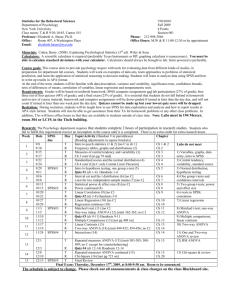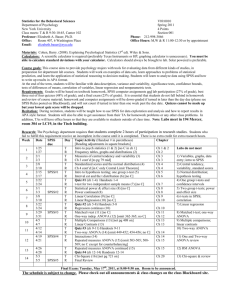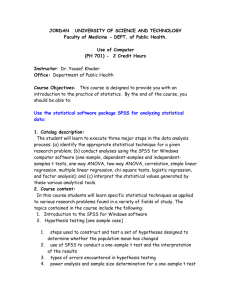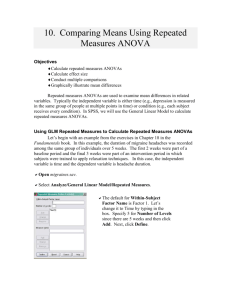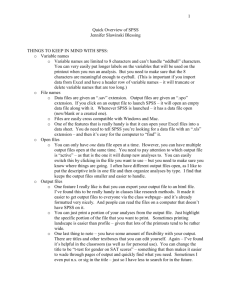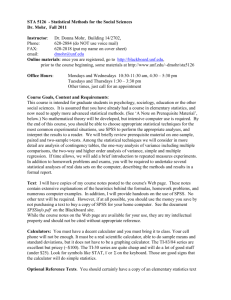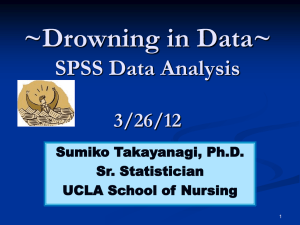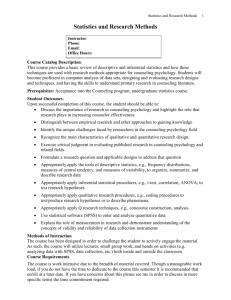Syllabus - Holtgraves
advertisement
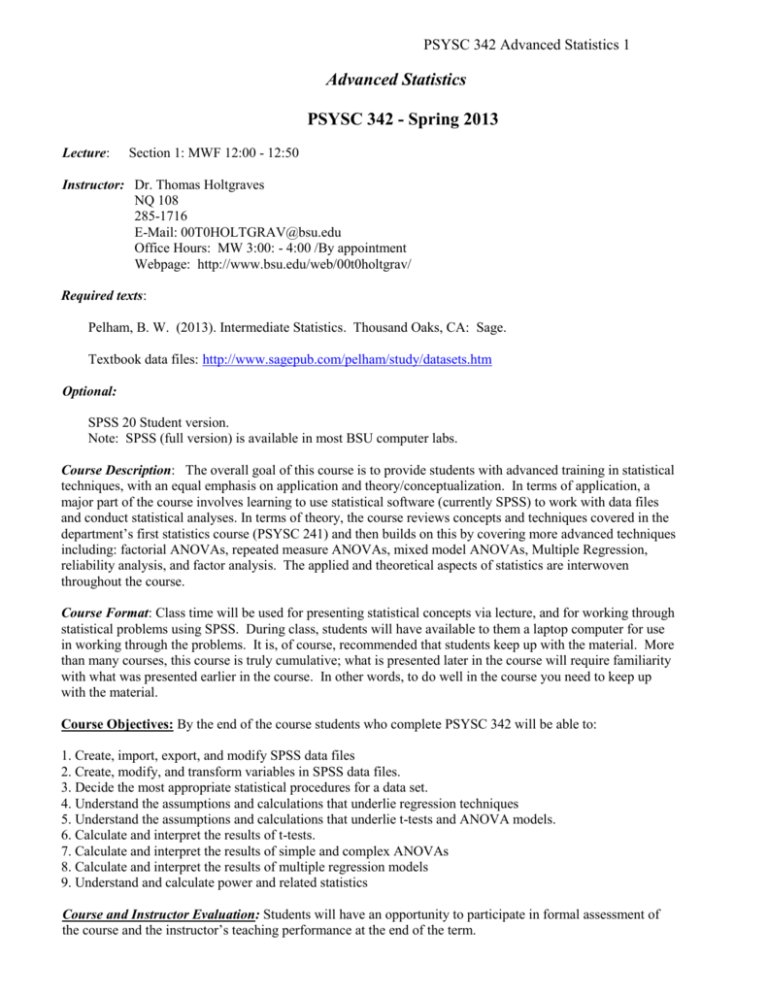
PSYSC 342 Advanced Statistics 1 Advanced Statistics PSYSC 342 - Spring 2013 Lecture: Section 1: MWF 12:00 - 12:50 Instructor: Dr. Thomas Holtgraves NQ 108 285-1716 E-Mail: 00T0HOLTGRAV@bsu.edu Office Hours: MW 3:00: - 4:00 /By appointment Webpage: http://www.bsu.edu/web/00t0holtgrav/ Required texts: Pelham, B. W. (2013). Intermediate Statistics. Thousand Oaks, CA: Sage. Textbook data files: http://www.sagepub.com/pelham/study/datasets.htm Optional: SPSS 20 Student version. Note: SPSS (full version) is available in most BSU computer labs. Course Description: The overall goal of this course is to provide students with advanced training in statistical techniques, with an equal emphasis on application and theory/conceptualization. In terms of application, a major part of the course involves learning to use statistical software (currently SPSS) to work with data files and conduct statistical analyses. In terms of theory, the course reviews concepts and techniques covered in the department’s first statistics course (PSYSC 241) and then builds on this by covering more advanced techniques including: factorial ANOVAs, repeated measure ANOVAs, mixed model ANOVAs, Multiple Regression, reliability analysis, and factor analysis. The applied and theoretical aspects of statistics are interwoven throughout the course. Course Format: Class time will be used for presenting statistical concepts via lecture, and for working through statistical problems using SPSS. During class, students will have available to them a laptop computer for use in working through the problems. It is, of course, recommended that students keep up with the material. More than many courses, this course is truly cumulative; what is presented later in the course will require familiarity with what was presented earlier in the course. In other words, to do well in the course you need to keep up with the material. Course Objectives: By the end of the course students who complete PSYSC 342 will be able to: 1. Create, import, export, and modify SPSS data files 2. Create, modify, and transform variables in SPSS data files. 3. Decide the most appropriate statistical procedures for a data set. 4. Understand the assumptions and calculations that underlie regression techniques 5. Understand the assumptions and calculations that underlie t-tests and ANOVA models. 6. Calculate and interpret the results of t-tests. 7. Calculate and interpret the results of simple and complex ANOVAs 8. Calculate and interpret the results of multiple regression models 9. Understand and calculate power and related statistics Course and Instructor Evaluation: Students will have an opportunity to participate in formal assessment of the course and the instructor’s teaching performance at the end of the term. PSYSC 342 Advanced Statistics 2 Special Needs: If you need course adaptations or accommodations because of a disability, if you have emergency medical information to share with the instructor, or if you need special arrangements in case the building must be evacuated, please make an appointment with me as soon as possible. The website (www.bsu.edu/dsd ) for the Office of Disabled Student Development is a great resource, with helpful tips for navigating successfully through school when you have a disability. DSD is located in the Student Center 307 or call 765.285.5293. TDD users call 765.285.2206. Academic Integrity and Dishonesty: Students are expected to complete all homework, exams, and projects independently; any work must be yours and yours alone. Relying on students' work from previous semesters and/or plagiarizing published research will be considered cheating. If you have questions about what constitutes plagiarism, please ask the teaching assistant or the instructor. Evidence of academic dishonesty will result in a punishment up to failure of the course and a report will be filed. Students who lose points because of academic dishonesty will not be allowed to earn extra credit points. University policy on academic dishonesty can be found in Section VIII of the Student Code, available at http://www.bsu.edu/sa/srcs/studentcode/ Homework: Homework will be assigned regularly. Scores on homework assignments will constitute 1/3 of the final grade. Exams: Exams will constitute 2/3 of the final grade. There will be both in-class (1/3 of final grade) and takehome exams (1/3 of final grade). Course Outline Topic Readings Creating and editing SPSS data files Basic concepts Chapter 1 (pp. 1-10) Measures of central tendency and variability SPSS data description Chapter 2 Probability and hypothesis testing Chapter 1 (pp. 11-42) SPSS transformations Appendix 6.2 (pp. 183-190) One sample t-test Chapter 6 Two independent sample t-tests Two related sample t-tests Nonparametric Techniques Chapter 4 Factor Analysis and Reliability Chapter 5 PSYSC 342 Advanced Statistics 3 EXAM 1 One-Way Analysis of Variance (ANOVA) Chapter 7 Factorial ANOVA Repeated Measures ANOVA Chapter 8 Mixed Model ANOVA Analysis of covariance (ANCOVA) Chapter 11 Power EXAM 2 Correlation Chapter 3 Multiple Regression Chapter 9 Chapter 10 Regression and Supression Chapter 12 Mediation and Path Analysis Chapter 13 Choosing Tests EXAM 3
